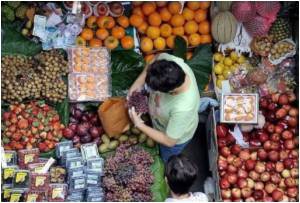
The Healthy People 2010 objectives set by the CDC include goals that 75% of people age 2 and over eat two or more servings of fruit daily and 50% eat three or more servings of vegetables daily. But almost all states in the country have fallen far short of the target, it seems.
The CDC, in its Morbidity and Mortality Weekly Report for Sept. 10, says that, in 2009, an estimated 32.5% of adults consumed fruit two or more times per day and only 26.3% consumed vegetables three or more times per day.
The CDC analyzed data from the Behavioral Risk Factor Surveillance System (BRFSS), an ongoing, state-based, telephone survey of the non-institutionalized U.S. civilian population aged 18 years and above.
Overall, the proportion of adults who met the fruit target declined slightly, but significantly, from 34.4% in 2000 to 32.5% in 2009; no significant change was observed in meeting the vegetable target. No state met either target, and substantial variability occurred among states. Only one state had statistically significant increases in the percentages of adults meeting each target.
In 2009, the highest percentage in consuming fruits was registered in Washington DC (40.2%) and the lowest in Oklahoma (18.1%). The percentage of adults who consumed vegetables three or more times per day was 26.3%, with the highest percentage in Tennessee (33.0%) and the lowest in South Dakota (19.6%). Thus, no state met either of the Healthy People 2010 targets related to fruit and vegetable consumption among adults. Twelve states and DC had 35%--45% of adults who consumed fruit two or more times per day, compared with no states that had 35%--45% of adults who consumed vegetables three or more times per day .
The report also reveals characteristics about subgroups that are showing more improvement in reaching CDC goals. For example:
• 36.1% of women compared to 28.7% of men ate fruit two or more times per day in 2009, and 30.9% of women compared to 21.4% of men ate vegetables at least three times daily.
• 41.3% of people 65 and older ate the recommended portions of fruit, and 29% ate vegetables three or more times daily.
• 36.9% of college graduates ate enough fruit, and 32.2% ate the recommended amount of vegetables.
• 32.9% of people with annual household incomes of $50,000 or more ate the recommended amount of fruits, and 29.4% vegetables.
• Hispanics had the highest prevalence of fruit consumption at 37.2% but the lowest prevalence of vegetable consumption, 19.7%.
• 36.9% of college graduates met fruit guidelines, and 32.2% ate the recommended amounts of vegetables. These findings underscore the need for interventions at national, state, and community levels, across multiple settings (e.g., worksites, community venues, and restaurants) to improve fruit and vegetable access, availability, and affordability, as a means of increasing individual consumption, the CDC stressed.
The findings in this report indicate that 20 states had a state-level food policy advisory council, but only eight had enacted healthy food retail policies (e.g., tax incentives, low-interest business loans, and zoning for stores, markets, and stands), and states having farmers markets that accept electronic benefit transfers (the system delivering benefits in the federal Supplemental Nutrition Assistance Program) ranged from zero to 50%.
To improve access, availability, and affordability of fruits and vegetables through retail stores, farmers markets, farm-to-institution, worksite food standards, and other policy and environmental interventions, CDC provides guidance and funding to 25 states.
Source-Medindia













